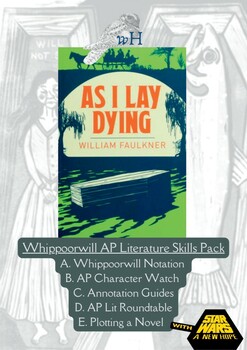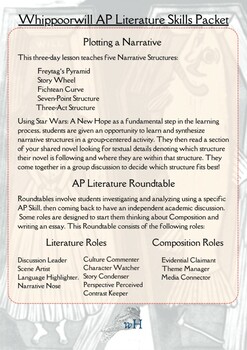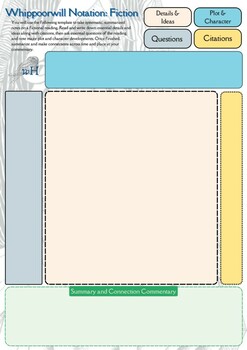As I Lay Dying by William Faulkner—AP Lit & Composition Skills Pack (4-6 Weeks)
- PDF
What educators are saying
Description
General Overview
As I Lay Dying by William Faulkner is a challenging novel if only for its dialectal prose ever shifting between 15 voices, but the piecemeal historical telling of Addie’s legacy is masterful; and it is ideal for the AP Classroom. A snippet from The Guardian: “This is the first (on this list), and probably the most popular, of Faulkner’s Yoknapatawpha County stories, a short, dark and compelling novel set in what he called “my apocryphal county”, a fictional rendering of Lafayette County in his native Mississippi. It was his ambition, he said, after the comparative failure of The Sound and the Fury, “deliberately to write a tour de force”. Apart from Mark Twain (No 23 in this series), no other American writer before Faulkner had ever immersed his readers so completely in the vernacular language and culture of a society that was, and perhaps still is, so deeply foreign to mainstream American experience.
The death and burial of a southern matriarch, Addie Bundren, is told from some 15 viewpoints, including that of the dying woman herself. The Bundren family’s demanding stream-of-consciousness narrative (Faulkner was a modernist pioneer) is intercut with the voices of the local doctor and preacher, together with neighbours and friends. From the first line, the reader is pitched into the deep south: “Jewel and I come up from the field, following the path in single file… anyone watching us from the cotton-house can see Jewel’s frayed and broken straw hat a full head above my own.” Welcome to a brutal, backwoods community of impoverished cotton farmers in 1920s Mississippi."
Here are four visually themed activities and some visually themed reading tools that should function for 12-15 classes depending on how you want to move through the text and build toward an assessment. These activities will help your students hone the specific skills necessary to start composing commentary about literature, discussing literature independently and confidently, reading closely, following character development, understanding narrative structure, studying well, and appreciating fiction.
This independent work packet is themed to match your novel, with sharp designs and colorful functionality, but this is not a reading/teaching guide. This AP Skills Pack should help prepare students, along with the strategies they learn in their AP classroom, to write an essay about your shared novel, and should function as an exercise of the skills learned in class. If you want your students to dig into your themes and goals for class independently using the AP Skills required, let them actively analyze and discuss with Whippoorwill.
Please remember to leave a rating and/or comment. I would love feedback about how to improve this product!
Included
- Whippoorwill AP Literature and Composition Roundtable (3 Classes)
- Whippoorwill AP Annotate, Defend, Discuss (3 Classes)
- Whippoorwill AP Annotate, Thesis, Discuss (3 Classes)
- Whippoorwill AP Plotting a Novel with Star Wars (3 Classes)
- Whippoorwill AP Character Watch: Character Table and Character Sheets (for entire novel)
- Whippoorwill AP Notation Sheet: Fiction (for entire novel)
1. Whippoorwill AP Literature and Composition Roundtable
Short and Long Fiction, Skills: 1A-1C-1D-1E, 2A-2B-2C, 3A-3B-3E-3F, 4A-4B-4C, 5A-5B-5C, 6A-6B, 7A-7B-7C-7D
Overview
Assign the roles and reading for homework, and when the class next meets students engage in an academic discussion that is independent of the teacher, fueled by AP Lit Skills, and fun. Each student has responsibilities while reading AND while discussing, so these can both be assessed as you see fit.
This is meant for students to practice the skills they have used in both investigation, analysis, discussion, and the first steps of composition. Form-fitting, you may pick and choose which roles to assign, whether to use the Composition roles as a secondary activity rather than simultaneously with the Literature roles, or use this as a springboard for their next essay.
Literature Roles
- Discussion Leader - leads our day’s discussion
- Scene Artist - draw, quote, and explain details that best establish the setting
- Language Highlighter - find and explain figurative language like symbols, images, similes, etc..
- Narrative Nose - find and explain events driven by the plot and details driven by POV
- Culture Commenter - find and explain meaningful comparisons between your culture and those of the characters
- Character Watcher - document character developments and conflicts
- Story Condenser - summarize the reading, choose three moments that would best ‘sell’ the story
- Perspective Perceiver - find and explain details that reveal perspective from either the characters or narrator
- Contrast Keeper - find and explain three contrasts, either character, narration, or values
Composition Roles
- Evidential Claimant - find five pieces of evidence you might use to make a defensible claim, explain your commentary
- Theme Manager - find and explain five details that relate to an overarching theme from class
- Media Connector - find and explain five details relating to another piece of media thematically, culturally, or otherwiseersummarize the reading, choose three moments that would best ‘sell’ the story
2. AP Literature and Composition Annotate, Defend, Discuss
Short Fiction, Skills: 1A, 2A, 3A-3B, 4A-4B
Overview
Students will read the text and annotate the document using the provided annotation guide. These colors correspond to the AP Literature and Composition skills above. The following categories should be annotated:
- Patterns in the language
- Plot and how it drives action and the narrative
- Character developments in motivation, action, and personality
- Narration and POV
- Setting and how it is established
- Evidence that helps students make a Claim about the text
Directions
1. (Class 1) Describe the skills of identifying the literary elements above, and explain that in the margins of their documents they should defend and explain these decisions, define unfamiliar words, and possibly make connections to other media.
2. (HW 1) Students read the text (or a portion of the text) and annotate accordingly.
3. (C2-HW2) Students use the evidence they’ve gathered to make defensible claims.
4. (C3) Students have a substantive conversation around the text using the quotes they have highlighted.
5. Students add Annotations to their text during discussion.
3. AP Literature and Composition Annotate and Discuss
Short Fiction II - Skills: 1A-1C-1D, 2B-2C, 3A-3D, 4A-4B-4C, 7B
Overview
Students will read the text and annotate the document using the provided color code. These colors correspond to the AP Literature and Composition skills above. Not only will students hone the skill of organizing their readings with visual markers, they will interpret literature and use evidence to make claims and a thesis. The following categories should be annotated:
- Contrasts - textual details that present character or societal values/traits in conflict with each other
- Plot - Events and actions oriented by a narrative plot
- Character - Textual details that reveal motivations, POV, and personality
- Narration - Textual details or modes of speech that identify the narrator’s POV
- Setting - Textual details of the setting creating mood or interacting with characters
- Evidence - Details that establish a defensible claim and could create a coherent line of reasoning
Directions
1. (Class 1) Describe the skills of identifying the literary elements above, and explain that in the margins of their documents they should defend and explain these decisions, define unfamiliar words, and possibly make connections to other media.
2. (HW 1) Students read the text (or a portion of the text) and annotate accordingly.
3. (C2-HW2) Students use the evidence they’ve gathered to make defensible claims, write a thesis, and formulate a general line of reasoning.
4. (C3) Students have a substantive conversation around the text using other quotes they have highlighted.
5. Students add Annotations to their text during discussion.
Students should be well-versed with each of the categories for the annotations. Some are broader than others, some overlap, but gearing students toward annotating the ‘most noticeable or important’ of these will help. Some details inform Character, Plot, and Narrative voice more than others, some Contrasts are more essential to the overarching message of the text than others, etc. Obviously, your may choose which of these to focus on, as well! I often assign with four of the categories, then use the others for active investigation and discussion in class the next day.
Evidence is something that they will need to work on. They might not know their claim until well after they finish reading, but gearing the students towards ‘clues’ will make them more apt to hunt for meaning in a text. These are the next steps toward writing essays, using a set of evidence to make a claim and formulating your interpretation of the text into a thesis and outline. Remind them to cite properly!
4. AP Literature Character Watch
Long Fiction - Skills: 1A-1B-1C-1D-1E
While reading, students use these tools to keep track of character development. These sheets should be printed and given to each student, so as they read they can mark textual details that define Contrasts, Perspective, Appearance, Conflicts, and Defining Quotes. They may use the Character Tables OR choose to make their own individual Character Sheets — print as many as is needed for your novel.
5. AP Literature Plotting a Novel
Long Fiction - Skills: 3A-3B-3C-3E, 7D
Students watch Star Wars; learn about Five Narrative strucures; Freytag’s Pyramid, Fichtean Curve, Story Wheel, Three-Act Structure, and Seven-Point Structure; then synthesize their knowledge of these structures using A New Hope. After learning, students try to pinpoint where in their shared class novel they are on two different narrative structures, plotting quotes on diagrams and using textual details as evidence to defend their claims.
6. Whippoorwill AP Notation: Fiction
Long Fiction - Skills: Systematic Note Taking, Category 7
Here is where truly independent interaction with a text can take shape. Use this sheet as a general notation guide for a reading, allowing your students to start working toward staking claims about character a plot without buttresses.





